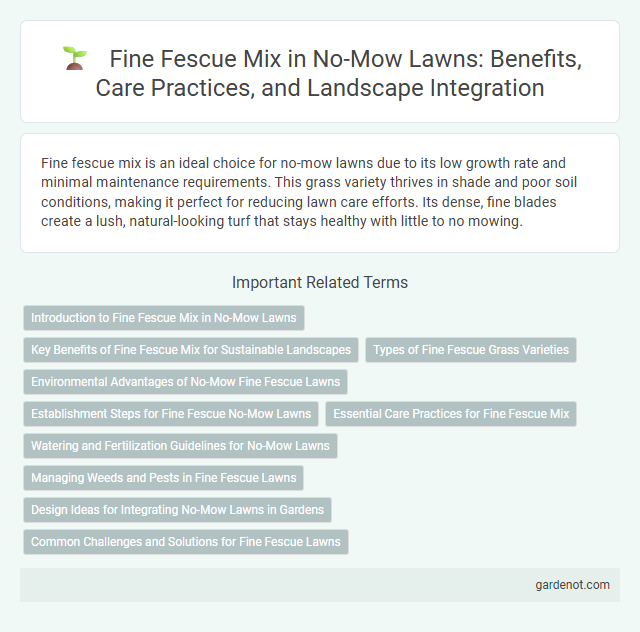Fine fescue mix is an ideal choice for no-mow lawns due to its low growth rate and minimal maintenance requirements. This grass variety thrives in shade and poor soil conditions, making it perfect for reducing lawn care efforts. Its dense, fine blades create a lush, natural-looking turf that stays healthy with little to no mowing.
Introduction to Fine Fescue Mix in No-Mow Lawns
Fine fescue mix, composed primarily of species like creeping red fescue, chewings fescue, and hard fescue, thrives in low-maintenance no-mow lawns due to its shade tolerance and drought resistance. This blend establishes dense, fine-textured turf that requires minimal mowing and irrigation, making it ideal for eco-friendly landscapes and water conservation efforts. Fine fescue mixes improve soil health by reducing erosion and supporting beneficial microorganisms in sustainable lawn care practices.
Key Benefits of Fine Fescue Mix for Sustainable Landscapes
Fine fescue mix thrives in low-maintenance landscapes, requiring minimal mowing and irrigation, which conserves water and reduces carbon emissions. Its drought tolerance and shade adaptability make it ideal for sustainable, eco-friendly lawns while supporting local biodiversity. The deep root system enhances soil health and erosion control, promoting long-term landscape resilience.
Types of Fine Fescue Grass Varieties
Fine fescue mix commonly includes varieties such as creeping red fescue, chewings fescue, hard fescue, and sheep fescue, each known for drought tolerance and low maintenance. Creeping red fescue offers excellent shade tolerance, while chewings fescue thrives in well-drained soils and contributes fine texture. Hard and sheep fescues provide durability and resistance to pests, making the blend ideal for no-mow lawns requiring minimal watering and infrequent mowing.
Environmental Advantages of No-Mow Fine Fescue Lawns
No-mow fine fescue lawns significantly reduce water consumption due to their deep root systems, promoting drought tolerance and lowering irrigation needs. These lawns enhance soil health by preventing erosion and supporting beneficial microbial activity, contributing to carbon sequestration and improving air quality. Their low maintenance reduces fossil fuel emissions commonly produced by lawn mowers, making no-mow fine fescue mixes an eco-friendly choice for sustainable landscaping.
Establishment Steps for Fine Fescue No-Mow Lawns
Fine fescue mix establishes best in well-prepared soil with good drainage and pH between 5.5 and 6.5. Sow seeds at a rate of 4 to 6 pounds per 1,000 square feet, lightly raking to cover and ensuring consistent moisture until germination, which typically occurs within 10 to 14 days. Mowing is minimized, with initial cutting done only to remove taller blades at about 3 inches once the grass reaches 4 inches in height.
Essential Care Practices for Fine Fescue Mix
Fine fescue mix thrives with minimal mowing, making it ideal for no-mow lawns. Essential care practices include maintaining well-drained soil, ensuring moderate irrigation to prevent overwatering, and applying a balanced, slow-release fertilizer in early spring for optimal growth. Regular overseeding every two to three years enhances density and resilience against weeds and environmental stress.
Watering and Fertilization Guidelines for No-Mow Lawns
Fine fescue mix thrives in no-mow lawns by requiring minimal watering, ideally about 1 inch per week, allowing the soil to dry slightly between sessions to promote deep root growth. Fertilization should be done sparingly, with a slow-release nitrogen fertilizer applied once in early spring and again in late fall to maintain a healthy, drought-resistant lawn. Avoid overwatering and excessive fertilization to prevent shallow roots and excessive growth, ensuring a low-maintenance, sustainable no-mow lawn.
Managing Weeds and Pests in Fine Fescue Lawns
Fine fescue mix thrives in no-mow lawns by naturally outcompeting many common weeds due to its dense growth and shade tolerance. Effective management of pests involves maintaining soil health and encouraging beneficial insects that prey on harmful species, reducing the need for chemical interventions. Regular monitoring for invasive weeds and timely removal helps preserve the lawn's integrity and promotes sustainable, low-maintenance turf.
Design Ideas for Integrating No-Mow Lawns in Gardens
Fine fescue mix thrives in no-mow lawn designs, offering drought tolerance and shade adaptability ideal for low-maintenance gardens. Incorporate native wildflowers and ornamental grasses to enhance biodiversity and create naturalistic borders that blend seamlessly with fine fescue's fine-textured blades. Strategic layering with ground covers and mulched pathways optimizes soil health and aesthetic appeal, elevating garden resilience while minimizing upkeep.
Common Challenges and Solutions for Fine Fescue Lawns
Fine fescue lawns often face challenges such as poor sunlight tolerance, vulnerability to drought, and susceptibility to fungal diseases. Proper soil aeration, consistent moisture management, and using disease-resistant seed varieties can significantly improve lawn health. Incorporating organic mulch and reducing foot traffic help maintain resilience and enhance the no-mow fine fescue mix's durability.
Fine fescue mix Infographic

 gardenot.com
gardenot.com